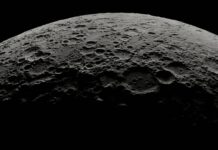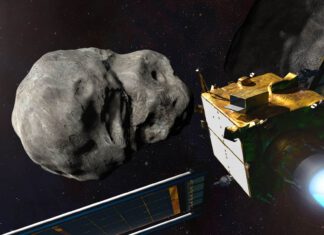
A New Insight into the Moon’s Exosphere
It is often stated that the Moon doesn’t have an atmosphere. That is not entirely true. There is indeed a very thin layer of atoms that forms a ring around the celestial body. More information has now been revealed about its origin.
Officially, it’s not called an atmosphere but an exosphere. On Earth, this is the outermost shell, where satellites orbit. The layer is at an altitude of 500 to 1000 kilometers, forming the transition to space.
Analysis of Apollo Samples
But how is it possible that the Moon has an exosphere, given that its gravity is too weak to hold onto air molecules? According to scientists from MIT and the University of Chicago, this is mainly due to something they call ‘impact vaporization.’ Over its 4.5 billion-year history, the Moon has been continuously bombarded by meteorites. The impact of these collisions causes dust on the ground to be thrown upwards. Some atoms vaporize and remain suspended above the Moon, while others escape into space. This process leads to the formation of a thin atmosphere, constantly replenished by ongoing meteorite impacts. These conclusions are drawn based on the analysis of lunar soil samples collected by astronauts during the famous Apollo missions.
The Final Answer
“We are providing the definitive answer: impact vaporization is the primary process that has formed the Moon’s atmosphere,” says lead researcher Nicole Nie from MIT. “The Moon is nearly 4.5 billion years old, and during this time, its surface has been continuously bombarded by meteorites. We demonstrate that a thin atmosphere could eventually achieve a stable state as it was consistently replenished by small impacts across the entire Moon.”
Solar Winds and Meteorite Impacts
In 2013, NASA sent an orbiter to the Moon to collect information about its thin atmosphere, surface conditions, and any environmental influences on lunar dust. Scientists hoped that the measurements would confirm two processes that could explain how the Moon’s atmosphere was formed: impact vaporization and a phenomenon called ‘ion sputtering.’ The latter occurs when the solar wind, which carries charged particles from the Sun through space, strikes the lunar surface. These particles can transfer their energy to atoms in the soil, causing them to sputter into the air.
“Based on the data, it seemed that both processes play a role,” says Nie. “For example, they showed that during meteor showers, there are more atoms in the atmosphere, indicating that impacts have an effect. They also demonstrated that when the Moon is shielded from the Sun, such as during an eclipse, there are changes in the atmosphere, indicating that the Sun also has an impact. So, the results were not entirely clear.”
Tiny Lunar Grains
To pinpoint the origin of the Moon’s atmosphere more accurately, Nie examined ten lunar soil samples, each weighing only about 100 milligrams. Nie aimed to isolate two elements from each sample: potassium and rubidium. Both are ‘volatile,’ meaning they easily vaporize due to impacts. Each element can exist in different isotopes – variations of the same element with the same number of protons but slightly different numbers of neutrons. Potassium, for instance, can exist in three isotopes, each one neutron heavier than the previous. Similarly, rubidium has two isotopes.
The team reasoned that if the Moon’s atmosphere consists of atoms that have vaporized and risen into the air, lighter isotopes would ascend more easily, whereas heavier isotopes would likely fall back to the ground. They also hypothesized that impact vaporization and ion sputtering would lead to different isotope ratios in the soil. The specific composition of light and heavy isotopes in the soil for both potassium and rubidium would then clarify which process significantly contributes to the Moon’s atmosphere origin.
Powder Solution
The researchers ground the samples into a fine powder, dissolved them in acids, and separated the isotopes of potassium and rubidium. Using a mass spectrometer, they measured the different isotopes. The soil samples contained mostly heavy isotopes as expected. By comparing the two elements, the researchers concluded that impact vaporization primarily brought atoms into the atmosphere, forming the Moon’s thin exosphere.
Important Discovery
“With impact vaporization, most atoms remain in the Moon’s atmosphere, while ion sputtering causes many atoms to be ejected into space,” Nie explains. It is estimated that at least 70 percent of the Moon’s atmosphere is a product of meteorite impacts, with the remaining 30 percent resulting from the solar wind.
Cambridge researcher Justin Hu, who was not involved in the study, comments: “This discovery goes beyond a better understanding of the Moon’s history. Such processes could also occur and even be more significant on other moons and asteroids.”
“Without these Apollo samples, we wouldn’t have precise data to understand things in more detail,” says Nie. “Therefore, it is important to bring samples from the Moon and other celestial bodies back to Earth to paint a clearer picture of the formation and evolution of the solar system.”











